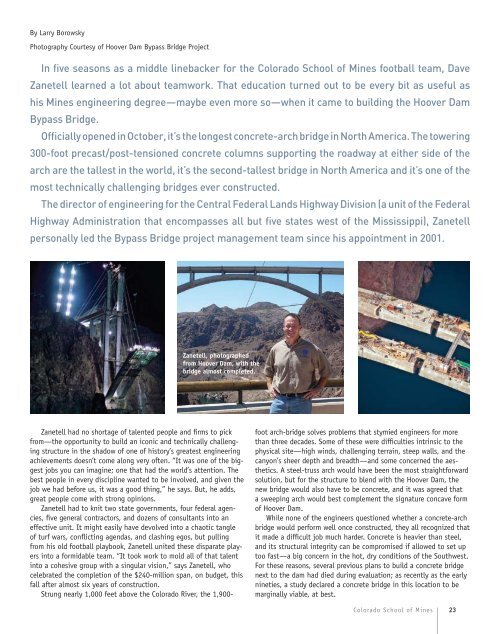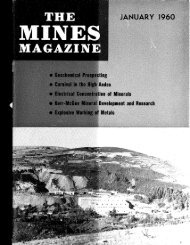Mines Magazine Turns 100 - the Timothy and Bernadette Marquez ...
Mines Magazine Turns 100 - the Timothy and Bernadette Marquez ...
Mines Magazine Turns 100 - the Timothy and Bernadette Marquez ...
- No tags were found...
You also want an ePaper? Increase the reach of your titles
YUMPU automatically turns print PDFs into web optimized ePapers that Google loves.
By Larry BorowskyPhotography Courtesy of Hoover Dam Bypass Bridge ProjectIn five seasons as a middle linebacker for <strong>the</strong> Colorado School of <strong>Mines</strong> football team, DaveZanetell learned a lot about teamwork. That education turned out to be every bit as useful ashis <strong>Mines</strong> engineering degree—maybe even more so—when it came to building <strong>the</strong> Hoover DamBypass Bridge.Officially opened in October, it’s <strong>the</strong> longest concrete-arch bridge in North America. The towering300-foot precast/post-tensioned concrete columns supporting <strong>the</strong> roadway at ei<strong>the</strong>r side of <strong>the</strong>arch are <strong>the</strong> tallest in <strong>the</strong> world, it’s <strong>the</strong> second-tallest bridge in North America <strong>and</strong> it’s one of <strong>the</strong>most technically challenging bridges ever constructed.The director of engineering for <strong>the</strong> Central Federal L<strong>and</strong>s Highway Division (a unit of <strong>the</strong> FederalHighway Administration that encompasses all but five states west of <strong>the</strong> Mississippi), Zanetellpersonally led <strong>the</strong> Bypass Bridge project management team since his appointment in 2001.Zanetell, photographedfrom Hoover Dam, with <strong>the</strong>bridge almost completed.Zanetell had no shortage of talented people <strong>and</strong> firms to pickfrom—<strong>the</strong> opportunity to build an iconic <strong>and</strong> technically challengingstructure in <strong>the</strong> shadow of one of history’s greatest engineeringachievements doesn’t come along very often. “It was one of <strong>the</strong> biggestjobs you can imagine; one that had <strong>the</strong> world’s attention. Thebest people in every discipline wanted to be involved, <strong>and</strong> given <strong>the</strong>job we had before us, it was a good thing,” he says. But, he adds,great people come with strong opinions.Zanetell had to knit two state governments, four federal agencies,five general contractors, <strong>and</strong> dozens of consultants into aneffective unit. It might easily have devolved into a chaotic tangleof turf wars, conflicting agendas, <strong>and</strong> clashing egos, but pullingfrom his old football playbook, Zanetell united <strong>the</strong>se disparate playersinto a formidable team. “It took work to mold all of that talentinto a cohesive group with a singular vision,” says Zanetell, whocelebrated <strong>the</strong> completion of <strong>the</strong> $240-million span, on budget, thisfall after almost six years of construction.Strung nearly 1,000 feet above <strong>the</strong> Colorado River, <strong>the</strong> 1,900-foot arch-bridge solves problems that stymied engineers for morethan three decades. Some of <strong>the</strong>se were difficulties intrinsic to <strong>the</strong>physical site—high winds, challenging terrain, steep walls, <strong>and</strong> <strong>the</strong>canyon’s sheer depth <strong>and</strong> breadth—<strong>and</strong> some concerned <strong>the</strong> aes<strong>the</strong>tics.A steel-truss arch would have been <strong>the</strong> most straightforwardsolution, but for <strong>the</strong> structure to blend with <strong>the</strong> Hoover Dam, <strong>the</strong>new bridge would also have to be concrete, <strong>and</strong> it was agreed thata sweeping arch would best complement <strong>the</strong> signature concave formof Hoover Dam.While none of <strong>the</strong> engineers questioned whe<strong>the</strong>r a concrete-archbridge would perform well once constructed, <strong>the</strong>y all recognized thatit made a difficult job much harder. Concrete is heavier than steel,<strong>and</strong> its structural integrity can be compromised if allowed to set uptoo fast—a big concern in <strong>the</strong> hot, dry conditions of <strong>the</strong> Southwest.For <strong>the</strong>se reasons, several previous plans to build a concrete bridgenext to <strong>the</strong> dam had died during evaluation; as recently as <strong>the</strong> earlynineties, a study declared a concrete bridge in this location to bemarginally viable, at best.Colorado School of <strong>Mines</strong> 23

















